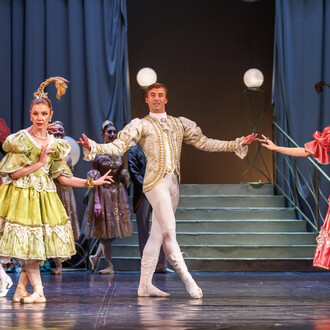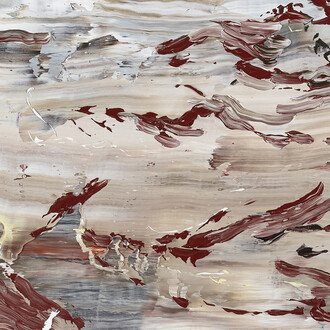Nestled between Monte Pellegrino and the Gulf of Palermo, Villa Igiea is more than a hotel: it is a portal into history, memory, and the ever-shifting landscape of Mediterranean culture. Originally envisioned as a sanatorium by the illustrious Florio family and later transformed into a grand hotel, Villa Igiea has been restored by Rocco Forte Hotels, blending Belle Époque grandeur with contemporary design. Its sweeping views over the sea, terraced gardens, and frescoed interiors offer not only a tranquil setting but also a space attuned to the rhythms of art and nature.
It is within this setting — suspended between past and present — that Bertozzi & Casoni unveil their latest sculptural exhibition: What we see is not what it is. Conceived in recognition of World Contemporary Art Day and in homage to Sicilian ceramic tradition, the exhibition reimagines the hotel as a temporary theater of transformation. Through their hyperrealistic sculptures, the artist duo invites reflection on the transience of time, the persistence of beauty, and the invisible threads connecting objects, history, and imagination.
Walking through the salons and gardens of Villa Igiea, the works appear as apparitions — too real to be illusions, too poetic to be mere replicas of the real. Bertozzi & Casoni’s ceramic compositions are not simple homages but complex meditations on art history, temporality, and meaning. A series of three vases, delicately placed on a console table, echoes the silent compositions of Giorgio Morandi. The stillness is almost tactile: porcelain flowers caught in an eternal moment of suspension, echoing Morandi’s metaphysical silence.
In the adjoining room, a luminous tribute to Vincent van Gogh takes form through a vibrant bouquet of sunflowers. Here, the iconic subject is translated into ceramic with uncanny realism, yet reinterpreted with bold, sculptural weight. It is a Van Gogh that has stepped out of the frame, challenging the limits of material and time. Nearby, violin cases cradling slashed canvases pay tribute to Lucio Fontana. These works are not literal reconstructions but ceramic reliquaries of a radical gesture — the artist’s cut — which opened painting to space, void, and spiritual depth.
At the heart of the exhibition is a central paradox: the use of fragile, earthly ceramic to speak of transcendence, memory, and decay. Bertozzi & Casoni do not merely imitate reality; they elevate the everyday into emblem and metaphor. A wilted flower, a broken object, or a suitcase left ajar becomes an allegory of time’s passing, of the beauty that lingers even in ruin, and of the stories we project onto the things we leave behind.
But why Villa Igiea? Why Palermo?
Because Villa Igiea is not just a place — it is a story. Its walls have witnessed travelers, poets, artists, and aristocrats. Its gardens have collected secrets whispered in the wind. Its architecture, both majestic and intimate, seems to bend time. The exhibition finds in this place a natural counterpart. Just as the sculptures speak of transformation, nostalgia, and suspended moments, Villa Igiea mirrors these themes in its very stones.
And Palermo — a city of contrasts and stratifications — is the perfect backdrop for this dialogue. A city where decay and splendor coexist, where the baroque meets the brutal, where sea winds carry myths and memories, Palermo resonates with the dualities embodied in Bertozzi & Casoni’s practice. Their works are grounded in craftsmanship, yet open to conceptual inquiry. They reference local tradition (ceramics, Sicilian culture) while engaging in broader conversations about art, temporality, and perception.
During the vernissage, a performance by musicians from Teatro Massimo — Palermo’s opera house — further deepened the experiential dimension of the exhibition. The music, composed and performed site-specifically, echoed through the frescoed halls and down into the gardens, creating a sensorial dialogue between sculpture and sound, presence and absence. The performance followed the cycles of life, echoing the exhibition’s central question: What remains of a sound once heard? What remains of an image when we close our eyes?
As curator, I wanted this exhibition to pose questions, not offer conclusions. What we see is never just what is there. It is also shaped by our memories, our wounds, and our dreams. Reality, as philosopher Merleau-Ponty reminds us, is not a fixed image but a lived experience — always mediated by perception. What We See Is Not What It Is explores this space in-between: the fertile tension between reality and imagination, object and symbol, eye and soul.
In that sense, each sculpture by Bertozzi & Casoni becomes a threshold. It invites us to cross into another layer of meaning, to engage in slow looking, and to suspend our judgments. A burnt book, a crumpled flower, or a cracked surface — these are not simply “things,” but triggers. They awaken a recognition in us, a feeling of déjà vu, or perhaps the hint of something lost but not forgotten.
The exhibition is more than a collection of artworks — it is a meditation on the visible and the invisible. It invites the viewer to question their relationship with reality and to understand that every image contains a shadow, and every object a memory. As the title suggests, what we see is always filtered through what we are.
This interplay between sculpture and site transforms Villa Igiea into a space of shared reflection. The exhibition dissolves the boundary between the art space and the lived space, between contemplation and hospitality. Visitors become participants in a multi-sensory, immersive experience — one that lingers after the visit ends.
Ultimately, What we see is not what it is is an invitation — to observe more attentively, to remember more deeply, and to feel more fully. And perhaps that is what art continues to offer: a way of seeing the world — and ourselves — differently.
So why should we visit this exhibition?
Because it reminds us that even in a flower made of ceramic, we might recognize life, fragility, and wonder. Because in overlooked places — a sculpted object, a forgotten garden, a slashed surface — we sometimes rediscover the meaning of being present.










